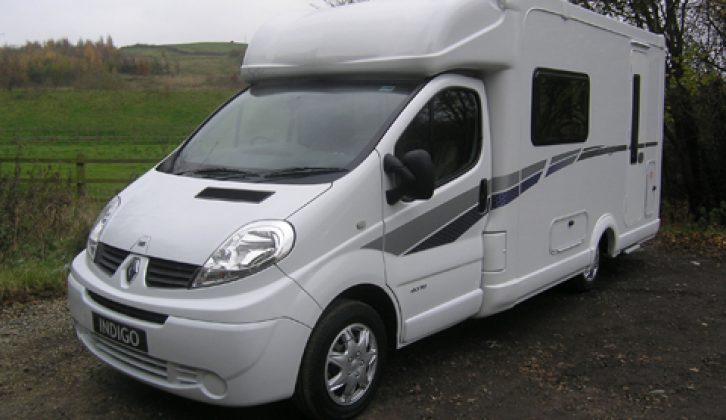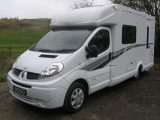Verdict
A classic two-berth, end-kitchen layout that’s beautifully assembled. Down-sizers may be swayed by the car-like drive, narrow dimensions and promise of top aftersales.
Pros
Good storage access; clever control panel; swing-wall washroom; decent amount of storage options; integrated sat-nav and passenger airbag as standard
Cons
Body roll in corners; narrow wing mirrors
Launched with some fanfare at the October 2010 NEC show, Bentley Motorhomes is an all-new British brand. Father-and-son team Gordon (design) and Richard (sales) Bentley bring an enviable pedigree to the venture: Gordon was the founder of Autocruise, a brand that earned a loyal following for its top notch aftersales service – something Bentley Motorhomes plans to major in.
At the time of our test, Richard Bentley explained they’d appointed eight dealers, all of which were family-oriented retailers, including names such as Heart of England motorhomes and Fullers, which regularly features in our annual Practical Motorhome owner satisfaction survey.
The three-model Artisan range of narrow-bodied coachbuilts targets a growing trend toward van conversions. A low-profile motorhome which, at just 2.08m wide, is not much broader than a typical van conversion, offers the best of both worlds, says Richard Bentley.
The external design is clean and attractive. All three models share the same GRP-skinned sidewalls and an overall 6.2m-long footprint. Our test ’van was fitted with the Elite Pack of colour-coded bumper, front fog lamps, air-con, electric windows and mirrors (£1198.50). Passenger airbag and a sat-nav integrated into the dash are standard.
On our test drive in a pre-production Indigo, we found the 2.0-litre 115bhp engine more than adequate. The six-speed manual ’box offered decent acceleration through the gears and there’s the alternative of a Quickshift automatic box (£850 + VAT). The ride is a little soft, with some body roll in corners, but there’s very little noise from the conversion. I’d have appreciated wider wing mirrors, though – you have to lean to see down the sides of the caravan body.
One criticism at launch was the payload figures quoted – just 265kg. Richard assured me that all production models will be re-plated (at no extra cost to the buyer) to ensure at least 400kg of user payload.
Step inside, and you can’t fail to be impressed by the build quality. All furniture is made in-house at the South Yorkshire factory, and feels built to last – open a locker door to see domestic-style hinges screwed into aluminium extrusions.
The BM-branded control panel includes a button to tell you how much battery life is left in hours and minutes, and what charge your solar panel (if you choose one) is putting into your battery.
The end-kitchen layout is a classic two-berth floorplan, with corner washroom and facing sofas up front. Interior headroom is decent, at 2m. Bentley chose not to cut away the Trafic cab’s steel roof, so the low-line roof mould allows space for overcab storage whilst maintaining Renault’s structural crash resistance, but this reduces cab-to-hab clearance to 1.23m. Our test ’van came without swivel cab seats, which shortens the lounging space, but they’re available as a cost option.
The sofas are comfy, with a chunky knee roll and deep backrest cushions. Panoramic windows and a Midi Heki rooflight do a good job of letting in daylight. Electrical lighting uses LED bulbs throughout, including strip lights integrated into the overhead lockers, and directional lights above each sofa. At night, the sofa frames slide to meet and create a comfy 2 x 1.5m double bed, or you can slide the cab seats forward and with infill cushions create two single beds at a shade under 2m each. Access to storage space under the seat benches is excellent –as well as external locker doors on both the driverside and nearside, the aluminium-framed, slatted seat tops open on self-supporting gas struts, plus there’s a separate flap on the seat box. Although the on-board fresh water tank and the Combi boiler/space heater are housed here, there’s a good amount of space left.
The kitchen area is compact but fully equipped: there’s a hob, oven and grill, with fridge/freezer opposite the dresser, plus a Dometic extractor hood. The dresser has a hinged extension to double as preparation space.
The washroom features Dometic’s ceramic-bowl toilet and a swing-wall shower that creates a decent 80 x 75cm cubicle. The tiled effect in the shower is bonded to the wall at the same time as the GRP outer skin, making it a finish likely to stand the test of time.
Technical Specifications
| Payload | 400 kg |
| MTPLM | 3300 kg |
| Shipping Length | 6.20 m |
| Width | 2.08 m |

